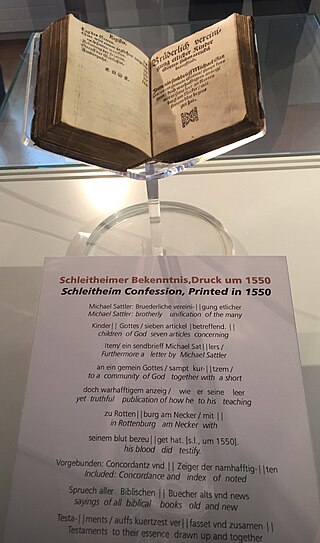Anabaptism is a Christian movement which traces its origins to the Radical Reformation in the 16th century. Anabaptists believe that baptism is valid only when candidates freely confess their faith in Christ and request to be baptized. Commonly referred to as believer's baptism, it is opposed to baptism of infants, who are not able to make a conscious decision to be baptized.

In Christian theology, "legalism" is a pejorative term applied to the idea that "by doing good works or by obeying the law, a person earns and merits salvation." The term has been criticized by certain Christian traditions, such as Conservative Anabaptists who have said that being a disciple of Jesus means being obedient to New Testament commands, and the same is "crucial evidence that an individual has repented, believed, and yielded to Christ."

Plain people are Christian groups in the United States, characterized by separation from the world and by simple living, including plain dressing in modest clothing. Many plain people have an Anabaptist background. These denominations are largely of German, Swiss German and Dutch ancestry, though people of diverse backgrounds have been incorporated into them. Conservative Friends are traditional Quakers who are also considered plain people; they come from a variety of different ethnic backgrounds.

The Schwarzenau Brethren, the German Baptist Brethren, Dunkers, Dunkard Brethren, Tunkers, or sometimes simply called the German Baptists, are an Anabaptist group that dissented from Roman Catholic, Lutheran and Reformed European state churches during the 17th and 18th centuries. German Baptist Brethren emerged in some German-speaking states in western and southwestern parts of the Holy Roman Empire as a result of the Radical Pietist revival movement of the late 17th and early 18th centuries, where people began to read and study their Bibles on their own- rather than just being told what to believe and do.

The Dunkard Brethren Church is a Conservative Anabaptist denomination of the Schwarzenau Brethren tradition, which organized in 1926 when they withdrew from the Church of the Brethren in the United States.

The Brethren in Christ Church (BIC) is a Christian denomination. Falling within the Anabaptist tradition of Christianity, the Brethren in Christ Church has roots in the Mennonite church, with influences from the revivals of Radical Pietism and the holiness movement. They have also been known as River Brethren and River Mennonites. The Canadian denomination is called Be In Christ.
The Rosedale Network of Churches is a Christian body of Mennonite churches in the Anabaptist tradition. Rosedale Network of Churches was originally formed in 1910 by a group of Amish Mennonites to promote unity while preserving autonomy of the local congregation.

Anabaptist theology, also known as Anabaptist doctrine, is a theological tradition reflecting the doctrine of the Anabaptist Churches. The major branches of Anabaptist Christianity agree on core doctrines but have nuances in practice. While the adherence to doctrine is important in Anabaptist Christianity, living righteously is stressed to a greater degree.
Peace churches are Christian churches, groups or communities advocating Christian pacifism or Biblical nonresistance. The term historic peace churches refers specifically only to three church groups among pacifist churches:
Nonresistance is "the practice or principle of not resisting authority, even when it is unjustly exercised". At its core is discouragement of, even opposition to, physical resistance to an enemy. It is considered as a form of principled nonviolence or pacifism which rejects all physical violence, whether exercised on individual, group, state or international levels. Practitioners of nonresistance may refuse to retaliate against an opponent or offer any form of self-defense. Nonresistance is often associated with particular religious groups, such as Anabaptist Christianity.
Amish Mennonites came into existence through reform movements among North American Amish mainly between 1862 and 1878. These Amish moved away from the old Amish traditions and drew near to the Mennonites, becoming Mennonites of Amish origin. Over the decades, most Amish Mennonites groups removed the word "Amish" from the name of their congregations or merged with Mennonite groups.
The Beachy Amish Mennonites, also known as the Beachy Amish or Beachy Mennonites, are a Conservative Anabaptist tradition of Christianity.

Radical Pietism are those Christian churches who decided to break with denominational Lutheranism in order to emphasize certain teachings regarding holy living. Radical Pietists contrast with Church Pietists, who chose to remain within their Lutheran denominational settings. Radical Pietists distinguish between true and false Christianity and hold that the latter is represented by established churches. They separated from established churches to form their own Christian denominations.

Plain dress is a practice among some religious groups, primarily some Christian churches in which people dress in clothes of traditional modest design, sturdy fabric, and conservative cut. It is intended to show acceptance of traditional gender roles, modesty, and readiness to work and serve, and to preserve communal identity and separation from the ever-changing fashions of the world. For men, this often takes the form of trousers secured by suspenders, while for women, plain dress usually takes the form of a cape dress along with a headcovering.
Conservative Mennonites include numerous Conservative Anabaptist groups that identify with the theologically conservative element among Mennonite Anabaptist Christian fellowships, but who are not Old Order groups or mainline denominations.
A Seeker is a person likely to join an Old Order Anabaptist community, like the Amish, the Old Order Mennonites, the Hutterites, the Old Order Schwarzenau Brethren or the Old Order River Brethren. Among the 500,000 members of such communities in the United States there are only an estimated 1,200 to 1,300 outsiders who have joined them.
Charity Ministries, also called Charity Christian Fellowship, is a Conservative Anabaptist network of churches that was formed in 1982 in Lancaster County, Pennsylvania.

A kapp is a Christian headcovering worn by many women of certain Anabaptist Christian denominations, as well as certain Conservative Friends and Plain Catholics, in obedience to Paul the Apostle's command in 1 Corinthians 11:2–10.

A hanging veil, also known as a flowing veil or charity veil, is a type of Christian headcovering, which is worn by some Christian women continually, in obedience to Paul the Apostle's command in 1 Corinthians 11:2–10. Hanging veils enjoy popularity in a diverse array of Christian denominations, especially those of the Anabaptist Christian tradition. In certain Conservative Mennonite Anabaptist congregationations of the Beachy Amish Mennonite tradition, an opaque hanging veil is permitted as an alternative to the kapp if it covers as much or more hair as the kapp, which traditionally is "of ample size to cover most of the hair". Opaque hanging veils are usually white or black in colour for modesty. Hanging veils are designed to drape over the natural curves of a woman's head and hang down a woman's neck. Certain denominations of Christianity provide guidelines regarding the headcovering; the Ministry Training Center of the Biblical Mennonite Alliance, for example, teaches:
A veiling shall be worn by the sisters. We believe the best application of the headship principle as taught in I Corinthians 11 is for the veiling to be worn as a part of their regular attire to cover hair that is allowed to grow to its natural length. Ladies shall wear all their hair neatly up, avoiding fashion extremes, covered with a hanging veil, scarf, or traditional Mennonite covering of sufficient size to substantially cover the hair. Hanging veils and scarves must cover at least from the crown of the head to the bottom of the hair bun.







